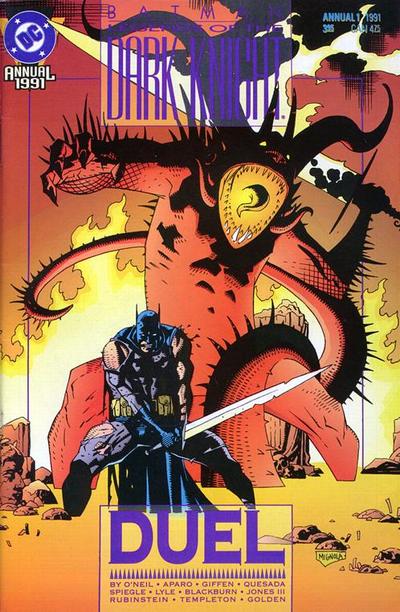In 1970, Frank Robbins and Neal Adams created the perfect adversary for Batman: Man-Bat! Even the name made perfect sense. Instead of having a man dressed as a bat to fight crime we have a bat in the shape of a man committing crimes although due to the beastly nature of the Man-Bat, one could argue that those are not in fact real crimes.
The idea behind Man-Bat is reminiscent of literary classics such as Dr. Jekyll and Mr. Hyde. We have this idea of a scientist who comes up with some sort of potion; upon drinking that potion this man, who is usually described as a very professional and intelligent individual, with high moral values and also a natural kindness in his heart, id est Dr. Jekyll, due to the potion will eventually be transformed into an opposite version of himself, a monster not only physically but also morally, id est Mr. Hyde. Here Dr. Kirk Langstrom is a zoologist with a specialization in the field of chiropterology, and he invents a strange serum and tests it on himself.
In “Wings” (July 1995), writer Chuck Dixon takes advantage of the concept of Batman as an urban legend, who is represented in newspapers as a bat creature, so there is certainly a lot of similarities between the hero and his adversary. Dixon also manages to tell a compelling story that involves Kirk Langstrom working as a scientist dealing with his insecurities and his fear of having a loving relationship with the woman of his dreams. After drinking the serum he is slowly turning into a monster, and we get to see the frustration, the pain and the emotional turmoil that the character goes through.
This story would not be the same without the magnificent art by Argentinian artist Quique Alcatena, whose precise brushes and inks give every page a unique texture, in which the amount of details is considerable. Every figure and every character help to create a notion of darkness. Alcatena is the perfect artist for gothic horror and we can see that in many of his designs, which celebrate dark Gothic architecture; in his representation of Batman, especially, we can see a darker than night figure, reminiscent of the designs that Leonardo da Vinci did while analyzing the wings of a bat.
Alcatena combines all of this into fascinating pages. I would consider this one of the best works in his career. Of course some of my favorite panels involve Man-Bat, but there is one in particular in which he is just holding the phone sitting on his bed and he looks absolutely miserable, he is indeed a monster but also a monster who dreams to become human again. Man-Bat therefore is not the typical villain that Batman must fight against. Man-Bat is a man trapped in a bad decision: he is Mr. Hyde trying to turn back into Dr. Jekyll. And of course Batman will help him achieve that goal.
________________________________________________________________________________________________________
________________________________________________________________________________________________________
En 1970, Frank Robbins y Neal Adams crearon al adversario perfecto para Batman: Man-Bat. Incluso el nombre tenía perfecto sentido. En lugar de tener un hombre vestido de murciélago para combatir el crimen, tenemos a un murciélago de forma humanoide que comete crímenes, aunque debido a la naturaleza bestial de Man-Bat, se podría argumentar que esos no son crímenes reales.
La idea detrás de Man-Bat recuerda a clásicos literarios como Dr. Jekyll y Mr. Hyde. Tenemos la idea de un científico que inventa algún tipo de poción; Al beber esa poción, este hombre, que generalmente se describe como un individuo muy profesional e inteligente, con altos valores morales y también una bondad natural en su corazón, o sea Dr. Jekyll, debido a la poción eventualmente se transformará en una versión opuesta de sí mismo, un monstruo no sólo físicamente sino también moralmente, o sea Mr. Hyde. Aquí el Dr. Kirk Langstrom es un zoólogo con especialización en el campo de la quiropterología, e inventa un suero extraño que prueba en sí mismo.
En “Alas” (julio 1995), el escritor Chuck Dixon aprovecha el concepto de Batman como una leyenda urbana, que se retrata en los periódicos como una criatura tipo murciélago, por lo que ciertamente hay muchas similitudes entre el héroe y su adversario. Dixon también logra contar una historia convincente que involucra a Kirk Langstrom trabajando como científico y lidiando con sus inseguridades y su miedo de tener una relación amorosa con la mujer de sus sueños. Después de beber el suero, poco a poco se está convirtiendo en un monstruo, y podemos ver la frustración, el dolor y la confusión emocional que atraviesa el personaje.
Esta historia no sería la misma sin el magnífico arte del artista argentino Quique Alcatena, cuyos precisos pinceles y tintas dan a cada página una textura única, en la que la cantidad de detalles es considerable. Cada figura y cada personaje ayudan a crear una noción de oscuridad. Alcatena es el artista perfecto para el horror gótico y lo podemos ver en muchos de sus diseños, que celebran la arquitectura gótica oscura; en su representación de Batman, sobre todo, podemos ver una figura más oscura que la noche, que recuerda los diseños que hizo Leonardo da Vinci al analizar las alas de un murciélago.
Alcatena combina todo esto en páginas fascinantes. Consideraría que este es uno de los mejores trabajos de su carrera. Por supuesto, algunas de mis viñetas favoritas involucran a Man-Bat, pero hay una en particular en la que él simplemente sostiene el teléfono sentado en su cama y se ve absolutamente miserable, de hecho es un monstruo, pero también un monstruo que sueña con convertirse en humano nuevamente. Por tanto, Man-Bat no es el típico villano contra el que Batman debe luchar. Man-Bat es un hombre atrapado en una mala decisión: es el Sr. Hyde que intenta volver a convertirse en el Dr. Jekyll. Y, por supuesto, Batman lo ayudará a lograr ese objetivo.


















